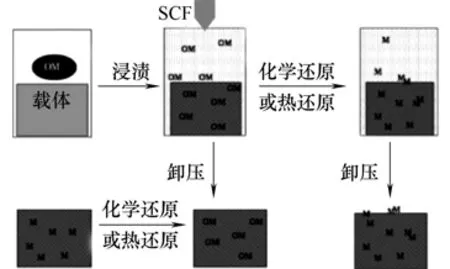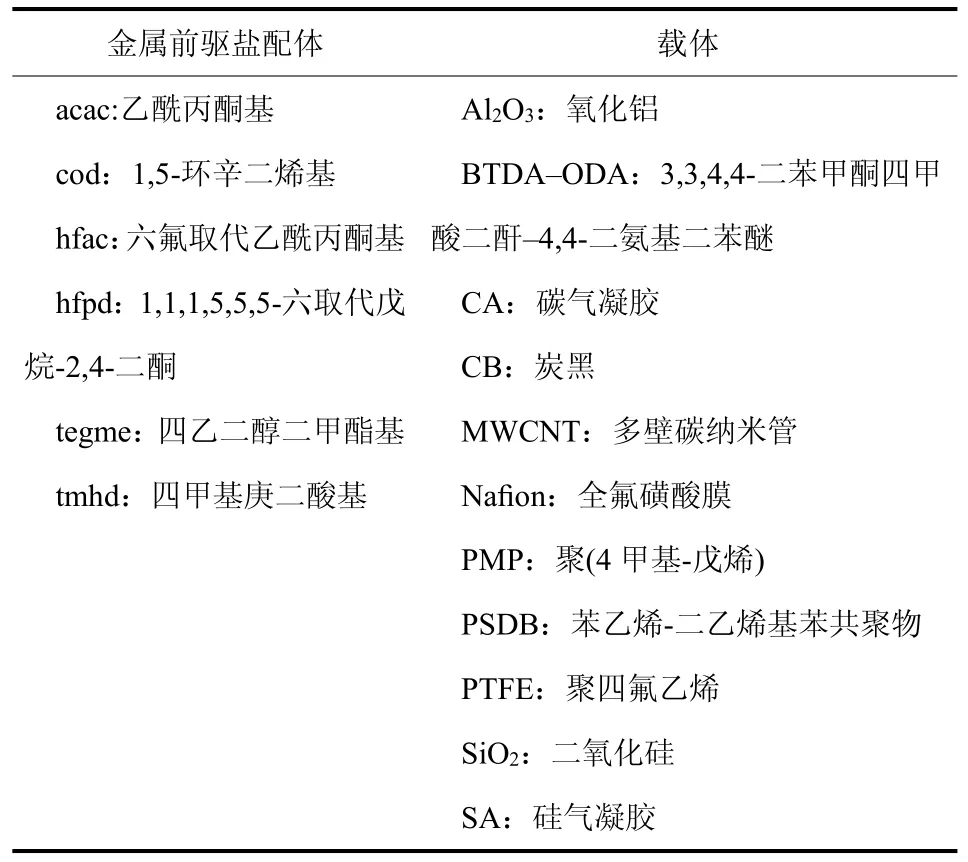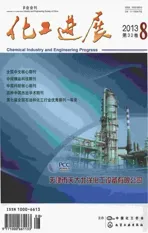超临界流体沉积技术制备负载型金属催化剂的研究进展
2013-08-08张以敏姜浩锡
张以敏,姜浩锡
(1 天津大学绿色合成与转化教育部重点实验室,天津 300072;2 天津大学石油化工技术开发中心,天津 300072)
1995年,Watkins 针对化学气相沉积法条件苛刻、无法深入内层沉积等缺点提出了一种活性成分负载催化剂的新型制备方法,即超临界流体沉积技术(supercritical fluid deposition,SFD)。它利用超临界流体低黏度、高扩散性、零表面张力以及易调变的优点,广泛应用于金属纳米颗粒[1-3]和金属膜[4-6]制备中。SFD的基本原理是浸渍、吸附的过程,保留了浸渍法的优点,整个过程可以分为3个步骤(图1):金属前驱盐在超临界流体中的溶解,金属前驱盐在载体上的吸附以及金属前驱盐在一定条件下还原为金属单质[7]。

图1 超临界流体沉积技术制备金属纳米颗粒的过程简图[7]
负载型金属催化剂的颗粒尺寸和分散性在很大程度上决定着它的催化活性。高分散、低粒径的催化剂由于具有较大的比表面积,其催化活性和使用效率很高[8]。Tomoyuki等[9]研究了活性炭负载Ru、Pt 及Pt-Ru 合金催化剂中金属颗粒的粒径与制备条件的关系及其对催化活性的影响,研究发现,负载贵金属催化剂中金属颗粒粒径的增大是导致催化剂活性降低的一个重要原因。在相同金属负载量条件下,较小的金属晶粒使得催化剂表面暴露更多的活性中心,活性金属比表面积增大[10]。Amandine等[11]在不同氧化物处理活性炭的基础上,制备出了不同粒径的Pd/AC并且考察了其对肉桂醛选择加氢催化活性的影响,结果表明目的产物的选择性随着Pd/AC 颗粒尺寸的增长而呈下降的趋势。Ahamadi等[12]在S 改性的CNTS 上制备出了不同粒径的Pt/CNT 并且研究了其作为燃料电池催化剂的电化学活性,同样得出了颗粒的聚集不利于其催化活性的结论。
近年来,许多研究者致力于超临界流体沉积技术制备金属纳米催化剂的研究并取得了一定的进展,但关于超临界流体沉积技术制备金属纳米催化剂的综述未曾出现,因此本文作者主要从金属前驱盐的溶解、吸附、还原3个方面来阐述超临界流体沉积技术制备负载型金属纳米催化剂的研究进展。
1 金属前驱盐在超临界流体中的溶解
1.1 金属前驱盐
金属前驱盐可以分为无机盐和有机盐两种,由于无机盐在超临界CO2中的溶解度很差,故在SFD中的应用很少。表1 中列举了常用的有机金属前驱盐的配体,表2 中列举了文献中使用到的金属前驱盐及其详细信息。
1.2 超临界流体
超临界流体是一种温度、压力分别高于临界温度(Tc)和临界压力(Pc)的流体,具有近乎于零的表面张力、较小的黏度、气体一样较大的扩散系数、液体一样较大的溶解性能,其溶解能力可以通过调节压力和温度来进行有效地控制。这些独特的性质使得超临界流体作为一种“绿色”媒介被广泛用于化学反应和分离的研究中[13]。而在诸多超临界流体中,超临界CO2和超临界水的应用最为广泛,除了具有超临界流体的性质外,还具有无毒、无污染、可循环的优点,因而废液的产生被大幅度减少。

表1 超临界流体沉积技术常用金属前驱盐配体和载体
1.3 金属前驱盐在超临界流体中的溶解度
金属前驱盐在超临界流体中的溶解度可以通过两种途径获得:实验测定和理论计算。实验测定的方法包括静态法和动态法。静态法是当体系达到平衡后,分析超临界流体相的组成,如Satoshi等[14]利用反相高压液相色谱静态法(RP-HPLC)测量了Ru、Rh、Pd等多种贵金属的化合物在SCCO2中的溶解度。动态法是指在超临界流体不断进入和流出的过程中分析流体的组成,如Hiroshi等[15]利用流动性萃取装置,即利用丙酮将溶解在SCCO2中的金属前驱盐萃取出来并对丙酮溶液进行紫外可见分析的方法,测量了Ti(Oi-Pr)2(dpm)2在SCCO2中的溶解度。相对来说,静态法设备简单,但是取样要求精确;动态法能够快速达到平衡,但设备相对复杂。理论计算法是用热力学知识建立溶解度的计算模型,可以大量节省实验测定的消耗[16]。目前理论计算方法主要包括立方型方程、正规溶液模型和经验方程。立方型方程的使用需要知道金属前驱盐的临界温度和临界压力,而由于金属前驱盐通常会在临界点到达之前就已经分解,因此这些数据通常是难以知道的,并且利用立方型方程预测得到的溶解度数据与实验的结果有很大的偏差,因此,很多研究者针对金属前驱盐在SCCO2中溶解度的经验模型进行了研究。目前使用最多的经验模型是Chrastil 模
型[14],在这个模型中,物质在超临界流体中的溶解度与超临界流体密度的对数成直线关系。尽管如此,目前尚没有普适的热力学模型描述超临界流体的特性及物质在其中的溶解行为。

表2 超临界流体沉积技术制备金属纳米颗粒的相关信息总结
目前,许多研究者针对文献中报道的金属前驱盐在SCCO2中的溶解度数据进行了总结。Smart等[17]对1995年以前的文献进行了综述;Skerget等[18]则总结了2005—2010年之间的文献数据。而在1995—2005年之间以及2010年以后也有很多文献报道了相关实验数据[19-20]。虽然金属前驱盐在SCCO2中的溶解度数据已经在多篇文献中报道,但金属前驱盐的种类繁多,几乎无法一一测量。因此许多学者致力于研究配体的分子结构对金属前驱盐溶解度的影响。他们发现:①含有配体-cp(环戊二烯基)和-co(羰基)的金属前驱盐较其它配体的金属前驱盐在SCCO2具有更高的溶解度;②含-acac 配体的金属前驱盐比含-cp、-cod、-thmd配体的金属前驱盐在SCCO2中的溶解度低[21];③含氟配体比不含氟配体的金属前驱盐在SCCO2中的溶解度高[19];④长链烷基和各种烷基基团会增加金属前驱盐在SCCO2中的溶解度,而芳香基团则不利于金属前驱盐的溶解。除此之外,Ortrud等[21]还对中心金属原子对溶解度的影响进行了研究,他们发现,在相同配体的条件下,中心原子的氧化价态越高,相对应的金属前驱盐在SCCO2中的溶解度就越高。
1.4 溶解过程中存在的问题及解决办法
近年来,贵金属-配体复合物广泛用于SFD 制备金属纳米催化剂,而纳米颗粒的尺寸和尺寸分布的控制问题是目前许多学者研究的热点。而这些复合物在SCCO2中的溶解度对沉积的过程、纳米颗粒的大小及尺寸分布都有很大的影响[14]。研究表明,金属前驱盐在SCCO2中的溶解度越高,对SFD 过程越有利。而目前的实验数据显示,金属前驱盐在SCCO2中的溶解度普遍不高[21]。
因此,提高金属前驱盐在SCCO2中的溶解度就成为许多学者研究的焦点。目前,在SFD 制备金属纳米颗粒的过程中,提高金属前驱盐在SCCO2中的溶解度的方法有两种:①用含氟配体的金属前驱盐[22];②在体系中添加共溶剂[23-24]。但有研究表明,含氟配体的金属前驱盐虽然在SCCO2中的溶解度较高,但用其制备出来的金属纳米催化剂由于负载量较低而无法进行表征[25]。因此,在金属前驱盐的选择上要谨慎,不能一概而论。
2 金属前驱盐在载体上的吸附
2.1 载体
催化剂载体应该具备以下条件:不参加化学反应;有一定的机械强度;具有较高的比表面积;具有特定的化学性质(如表面酸性、碱性等)。常用的催化剂载体有氧化铝(130 m2/g 或260 m2/g)、硅胶(800 m2/g)、二氧化硅(120 m2/g)、炭黑(290 m2/g)、活性炭、炭气凝胶(629~741m2/g)、SBA-15和新型载体碳纳米管等,见表1。Wong等[24]利用超临界流体沉积技术制备了氧化铝、聚丙烯等载体负载的金纳米颗粒,结果表明超临界流体沉积技术对多种载体具有普适性。Zhang等[26]在相同的条件下制备出了多种载体负载的Pt 纳米颗粒,结果显示所有载体负载的Pt 颗粒都均匀分布在表面,并且Al2O3负载的Pt 颗粒尺寸最小为1.2 nm。针对近年来文献报道的超临界流体沉积技术过程中所使用的多种载体,本文在表2 中给予一一列举。下文简单介绍一下其中几种最常用载体的特点。
活性炭作为催化剂载体具有微孔发达、比表面积大、抗酸碱、耐高温、形状易调、表面疏水性易调、活性金属易回收以及成本较低的优点。但是由于活性炭的物理结构和表面化学组成相对复杂,因此它作为催化剂载体在工业和科学研究中的应用还不是很广泛。
炭气凝胶[27]是通过对间苯二酚和甲醛在水中相互反应所得到的有机溶胶-凝胶进行超临界干燥制得的。它是由3~30 nm的炭颗粒相互连接而成,具有以下特征:隙间孔直径小于50 nm、孔径分布很窄;比表面积为400~1500 m2/g;具有块状、薄膜状、粉末状、微球状;具有导电性,这与其它气凝胶(如硅胶)不同;微孔结构和物理特性可以通过调节制备过程参数进行有效的调节。基于以上优点,炭气凝胶广泛应用于制备超临界电容材料、宽带非反射材料、吸附水溶液中离子的材料、作为柴油中有机硫组分的吸附剂。
碳纳米管(CNTS)是一种由60~70个碳原子组成的具有高度对称笼状结构的纳米材料。它具有良好的力学性能和导电性能以及小尺寸、化学稳定性好、高比表面积、活性金属易回收等优点。并且,研究结果表明,载体的比表面积越大,金属纳米颗粒的分散就越好;金属前驱盐的还原时间越短,金属纳米颗粒就越小。而碳纳米管的比表面积较高,负载在碳纳米管上的金属前驱盐还原也较快。这些优势使得它作为金属催化剂的新型载体得到了广泛的应用。根据碳纳米管的壁数,碳纳米管可以分为单壁碳纳米管(SCNTS)和多壁碳纳米管(MWCNTS),后者的制备工艺较前者成熟,因此多用于催化剂的载体。
2.2 吸附行为
一般来说,物质在多孔材料上的吸附过程主要包括外扩散、内扩散、孔内吸附以及表面扩散和吸附。而在超临界流体沉积技术制备金属纳米颗粒的过程中,金属前驱盐在载体上的吸附是另外一个重要的环节。金属前驱盐只有有效地在载体上吸附后,才能保证还原后的金属在载体上稳定地附着。
目前,学者们针对金属前驱盐在载体上吸附行为的研究主要集中在金属前驱盐在载体上的吸附动力学和吸附热力学[28-31]。而金属前驱盐在载体上的吸附热力学主要通过金属前驱盐-SCCO2-载体整个系统的吸附等温线来描述。通过分析吸附等温线,可以得到以下信息:①确定载体上吸附的金属前驱盐的量,进而获得载体上金属的负载量;②吸附等温线的变化趋势可以反映金属前驱盐和载体之间作用的强弱;③对比不同温度下的吸附等温线,可以估计吸附能。长远来说,吸附等温线还能对利用超临界流体沉积技术大规模制备金属纳米颗粒具有指导性意义[32-33]。另外,吸附动力学的研究也有利于采取相应的措施对金属纳米颗粒的尺寸进行控制。
研究表明,在超临界流体沉积过程中,金属前驱盐、载体和二氧化碳之间存在相互作用,也就是说,金属前驱盐并不是单纯沉积在载体的表面,而是和载体之间具有化学作用。因此,对金属前驱盐-SCCO2-载体的吸附热力学(即吸附等温线)的测量对超临界流体沉积过程的优化具有重要的意义。Saquing等[29]和Zhang等[34]分别对PtMe2(cod)-SCCO2-炭气凝胶和Ru(cod)(thmd)2-SCCO2-炭气凝胶的吸附等温线进行了测量。结果表明,两个体系的吸附等温线都可以利用Langmuir 模型进行拟合。并且通过对比两者的吸附等温线,发现出现最大吸附量所对应的超临界流体中金属盐的浓度远小于其在超临界流体中的溶解度。这说明金属前驱盐与载体之间的作用较金属前驱盐与CO2之间的相互作用强,导致金属前驱盐倾向于分布在载体当中。
为了优化SFD 过程,需要对影响吸附过程的各种因素(如温度、压力、金属前驱盐的浓度)进行研究,也就是测量一下不同沉积时间下金属前驱盐在载体上吸附量的变化,即金属前驱盐在载体上的吸附动力学。Saquing等[29,34-35]研究了温度、压力以及金属前驱盐的浓度对吸附量的影响,但尚未得到一个普适的变化规律。另外,Ortrud等[30]针对载体对吸附行为的影响也进行了研究,结果表明外表面积较大、孔道较为规则的规整填料对金属前驱盐的吸附速率较硅胶要快得多,而内表面积较大的硅胶对金属前驱盐的饱和吸附量却比规整填料高。除了实验测量之外,Zhang等[28]还利用模拟的方法对Ru(cod)(thmd)2-SCCO2-炭气凝胶的吸附动力学进行了研究,他们利用常微分方程组建立了吸附动力学的模型,而通过模型模拟的数据与实验数据的误差仅约为4.6%。
2.3 吸附过程中存在的问题及解决办法
尽管吸附等温线对超临界吸附过程的设计起到了举足轻重的作用,但是目前有关金属前驱盐在多孔载体上的吸附平衡数据很少[27,34,36]。
另外,研究者发现金属在载体上的负载越均匀、颗粒越小,所得到的负载型催化剂的活性中心就越多,进而催化剂的活性就越高[8-12]。因此在金属前驱盐用量相同的情况下,其在载体上的扩散和吸附效率越高,最终负载在载体上的金属就越多、越均匀。但目前金属前驱盐在载体上的扩散和吸附效率普遍偏低,这是影响超临界流体沉积过程的又一个重要的因素。
目前,解决金属前驱盐在载体上扩散和吸附效率普遍较低的问题,主要的方法是选择表面亲水性较高的载体或利用外来物质对载体进行改性或预处理以增加其表面的亲水基团,进而提高其表面的亲水性和吸附性能[12,37-38],另外,载体表面的官能团在金属前驱盐的吸附、还原过程中的具体作用和去向还有待进一步更为深入的研究。
3 金属前驱盐还原为金属
3.1 还原方法
如图1所示,金属前驱盐还原为金属有卸压和不卸压[36](即超临界条件下和常压下)两种途径,而每一种途径里面又分为化学还原和热分解还原。化学还原就是在体系中添加还原剂,而最常使用的还原剂就是H2[39-40],另外有研究者还利用醇类物质[1]对金属前驱盐进行还原。表2 列出了相关文献中所用到的还原方法。
金属纳米颗粒的尺寸、形貌、分布的影响因素有很多,包括还原方法、金属前驱盐的种类、金属前驱盐在载体上的负载量、还原温度和还原时间。Saquing等[36]研究了还原方法对Pt/CA的尺寸和形貌的影响。结果表明,在常压热还原中,颗粒的增长主要是由金属原子和金属前驱盐分子在载体表面的扩散所致;常压下,化学还原与热分解还原相比,前者的颗粒尺寸增长要快很多;常压热还原与超临界条件下进行热还原相比颗粒较小且为球形,这可能是由于超临界物质的存在造成了颗粒的增长和形状的不规则;但是超临界条件下进行热分解还原时,未吸附的金属前驱盐会继续吸附在由于部分前驱盐被还原而空出的活性位上,从而导致金属前驱盐直至完全被还原为止,这就增加了金属前驱盐的使用率以及催化剂的负载量;在超临界条件下通H2还原Pd 盐时,由于还原反应是Pd 自催化的过程,因此还原反应会在Pd 颗粒上完成,从而导致金属颗粒的增长。由此可见,超临界条件下进行原位还原的方法比常压还原法有利于控制颗粒的尺寸和分布;而原位还原法中,热分解还原法则优于H2还原法。至于超临界条件在还原过程中所起的具体作用,还需要进一步的研究。另外,以上结论目前仅适用于金属Pd的合成,其它金属是否符合上述结论还有待进一步理论研究和实验验证。
3.2 还原过程中存在的问题及解决办法
尽管许多研究者已经对超临界流体沉积的还原过程进行了许多研究,但是有关有机金属前驱盐还原过程的热动力学数据以及金属颗粒的形成机理[41]还是很贫乏,这就给金属有机配体的选择带来了困难。另外,金属前驱盐经过还原过程后并不是全部被还原成金属单质,有机配体离开金属原子后的存在形式也是一个未知数,有些副产物甚至还会影响到整个催化剂的性能。因此,对金属前驱盐的还原过程进行热重-质谱分析测出其还原产物就十分有必要,可目前的文献中对此方面的研究还很少见。
4 结语
超临界流体沉积技术提出至今已有17年的时间,相对于其它浸渍法等常规制备负载型金属纳米催化剂来说,是一种绿色、高效的纳米材料制备方法。在超临界流体沉积技术制备金属纳米颗粒的过程中,颗粒几乎是均匀分布在载体的表面,并且通过改变金属前驱盐、负载量、沉积的温度压力、还原方法等可以将颗粒的尺寸有效地控制在1~10 nm 范围内。另外,对超临界流体沉积的3个步骤——金属前驱盐的溶解、吸附、还原-进行深入的研究可以为颗粒的尺寸及形貌的控制提供理论依据。金属前驱盐在超临界流体中的溶解是超临界流体沉积过程的首要步骤,选择在超临界流体中溶解度较高的金属前驱盐将为后续工作起到事半功倍的作用。金属前驱盐在载体上的吸附和扩散效率越高,得到的金属纳米颗粒尺寸越小、分布越均匀,因此提前对载体进行改性或预处理就显得十分重要。金属前驱盐还原为金属的过程是超临界流体沉积的最后一环,还原过程的好坏将决定整个超临界流体沉积过程的成败,因此就需要对金属前驱盐的还原过程、颗粒的形成机理进行研究。总的来说,超临界流体沉积技术作为一种新型催化剂制备方法尚在发展的初期,还需要对其进一步研究。
[1]An Guimin,Yu Ping,Mao Lanqun,et al.Synthesis of PtRu/carbon nanotube composites in supercritical fluid and their application as an electrocatalyst for direct methanol fuel cells[J].Carbon,2007,45:536-542.
[2]Fu Jianwei,Wang Minghuan,Wang Shitao,et al.Supercritical carbon dioxide-assisted preparation of palladium nanoparticles on cyclotriphosphazene-containing polymer nanosphers[J].Applied Surface Science,2011,257:7129-7133.
[3]Morere J,Tenorio M J,Torralvo M J,et al.Deposition of Pd into mesoporous silica SBA-15 using supercritical carbon dioxide[J].The Journal of Supercritical Fluids,2011,56:213-222.
[4]Cabanas Albertina,Shan Xiaoying,Watkins James J.Alcohol-assisted deposition of copper films from supercritical carbon dioxide[J].Chemical Materials,2003,15:2910-2916.
[5]Hiroyuki Ohde,Steve Kramer,Scott Moore,et al.Low-temperature deposition of conformal copper films in supercritical CO2by catalytic hydrogen reduction of copper hexafluoroacetylacetonate[J].Chemical Materials,2004,16:4028-4031.
[6]Eiichi Kondoh.Deposition of Cu and Ru thin films in deep nanotrenches/holes using supercritical carbon dioxide[J].Japanese Journal of Applied Physics,2004,43(6):3928-3933.
[7]Zhang Y,Erkey C.Preparation of supported metallic nanoparticles using supercritical fluids:A review[J].The Journal of Supercritical Fluids,2006,38:252-267.
[8]Mu Y,Liang H,Hu J,et al.Controllable Pt nanoparticle deposition on carbon nanotubes as an anode catalyst for direct methanol fuel cells[J].J.Phys.Chem.B,2005,109(47):22212-22216.
[9]Tomoyuki K,Wataru S,Yasushi M.Particle growth behavior of carbon-supported Pt,Ru,Pt/Ru catalysts prepared by an impregnation reductive-pyrolysis method for direct methanol fuel cell anodes[J].Journal of Catalysis,2005,229:176-184.
[10]Lin B Y,Wang Y,Yu X J,et al.Physicochemical characterization and H2-TPD study of alumina supported ruthenium catalysts[J].Catal.Lett.,2008,124:178-184.
[11]Amandine Cabiac,Gerard Delahay,Robert Durand,et al.Controlled preparation of Pd/AC catalyst for hydrogenation reactions[J].Carbon,2007,45:3-10.
[12]Ahmadi Rezgar,Amini Mohammad K.Synthesis and characterization of Pt nanoparticle on sulfur-modified carbon nanotubes for mathanol oxidation[J].International Journal of Hygrogen Energy,2011,36:7275-7283.
[13]Wai C M,Hunt F,Smart N,et al.Method and apparatus for dissociating metals from metal compounds extracted into superctitical fluids:US,6132491[P].2000-10-17.
[14]Satoshi Yoda,Yoko Mizumo,Takeshi Furuya,et al.Solubility measurements of noble metal acetylacetonates in supercritical carbon dioxide by high performance liquid chromatography(HPLC)[J].The Journal of Supercritical Fluids,2008,44:139-146.
[15]Hiroshi Uchida,Kazuyuki Sekino,Yuma Hayawa,et al.Solubility of titanium diisopropoxide bis(dipivaloylmethanate) complex in supercritical carbon dioxide and its effect on supercritical fluid deposition process[J].The Journal of Supercritical Fluids,2012,66:59-65.
[16]陈兵.固体溶质在超临界流体中溶解度的关联模型研究[D].杭州:浙江工业大学,2010.
[17]Smart N G,Carleson T,Kast T,et al.Solubility of chelating agents and metal-containing compounds in supercritical fluid carbon dioxide[J].Talanta,1997,44:137-150.
[18]Skerget Mojca,Knez Zeljko,Knez-Hrncic Masa.Solubility of solids in sub-and supercritical fluids:A review[J].The Journal of Chemical&Engineering Data,2011,56:694-719.
[19]Erkey C.Supercritical carbon dioxide extraction of metals from aqueous solutions:A review[J].The Journal of Supercritical Fluids,2000,17:259-287.
[20]Jacobo Morère,Maria José Tenorio,Concepción Pando,et al.Solubility of two metal-organic ruthenium precursors in supercritical CO2and their application in supercritical fluid technology[J].The Journal of Chemical Thermodynamics,2013,58:55-61.
[21]Ortrud Aschenbrenner,Stephen Kemper,Nicolaus Dahmen,et al.Solubility of B-diketonates,cyclopentadienyls and cyclooctadiene complexes with various metals in supercritical carbon dioxide[J].The Journal of Supercritical Fluids,2007,41:179-186.
[22]Morley K S,Marr P C,Webb P B,et al.Clean preparation of nanoparticulate metals in porous supports:A supercritical route[J].J.Mater.Chem.,2002,12:1898-1905.
[23]Roggeman E J,Scurto A M,Brennecke J F.Spectroscopy,solubility,and modeling of cosolvent effects on metal chelate complexes in supercritical carbon dioxide solutions[J].Ind.Eng.Chem.Res.,2001,40:980-989.
[24]Wong B,Yoda S,Howdle S M.The preparation of gold nanoparticle composites using supercritical carbon dioxide[J].The Journal of Supercritical Fluids,2007,42:282-287.
[25]Yen C H,Cui X L,Pan H B,et al.Deposition of platinum nanoparticles on carbon nanotubes by supercritical fluid method[J].J.Nanosci.Nanotechnol.,2005,5(11):1852-1857.
[26]Zhang Y,Kang D,Saquing C,et al.Supported platinum nanoparticles by supercritical deposition[J].Ind.Eng.Chem.Res.,2005,44:4161-4164.
[27]Saquing C D,Cheng T T,Aindow M,et al.Preparation of platinum/carbon aerogel nanocomposites using a supercritical deposition method[J].J.Phys.Chem.,2004,108:7716-7722.
[28]Zhang Ying,Cangul Betul,Garrabos Yves,et al.Thermodynamics and kinetics of adsorption of bis(2,2,6,6-tetramethyl-3,5-heptanedionato)(1,5-cyclooctadiene)ruthenium(Ⅱ)on carbon aerogel from supercritical CO2solution[J].The Journal of Supercritical Fluids,2008,44:71-77.
[29]Saquing Carl D,Kang Dafei,Aindow Mark,et al.Investigation of the supercritical deposition of platinum nanopaticles into carbon aerogels[J].Microporous and Mesoporous Materials,2005,80∶11-23.
[30]Ortrud Aschenbrenner,Nicolaus Dahmen,Karlheinz Schaber,et al.Adsorption of dimethyl(1,5-cyclootadiene)platinum on porous supports in supercritical carbon dioxide[J].Ind.Eng.Chem.Res.,2008,47:3150-3155.
[31]Bayrak A,Kitkamthorn U,Aindow M,et al.Decoration of multiwall carbon nanotubes with platinum nanoparticles using supercritical deposition with thermodynamic control of metal loading[J].Scripta.Mater.,2007,56(2):101-103.
[32]Cocero M J,Garcıa J.Mathematical model of supercritical extraction applied to oil seed extraction by CO2+ saturated alcohol[J].The Journal of Supercritical Fluids,2001,20(3):229-243.
[33]Alonso E,Cantero F J,Garcia J,et al.Scale-up for a process of supercritical extraction with adsorption of solute onto active carbon:Application to soil remediation[J].The Journal of Supercritical Fluids,2002,24(2)∶123-135.
[34]Zhang Y,Kang D,Aindow M,et al.Preparation and characterization of ruthenium/carbon aerogel nanocompositesviaa supercritical fluid route[J].J.Phys.Chem.B,2005,109(7):2617-2624.
[35]Iwai Y,Higuchi M,Nishioka H,et al.Adsorption of supercritical carbon dioxide plus 2,6-and 2,7-Dimethyl-naphthalene isomers on NaY-Type zeolite[J].Ind.Eng.Chem.Res.,2003,42(21):5261-5267.
[36]Saquing C D,Kang D,Aindow M,et al.Investigation of the supercritical deposition of platinum nanoparticles into carbon aerogels[J].Micropor.Mesopor.Mater.,2005,80(1-3):11-13.
[37]Pinju Tsai,Chenghsien Yang,Weiche Hsu,et al.Enhancing hydrogen storage on carbon nanotubesviahybrid chemical etching and Pt decoration employing supercritical carbon dioxide fluid[J].International Journal of Hydrogen Energy,2010,35:11669-11680.
[38]Liu Jun,Ebert Anthony,Variava Meherzad F,et al.Surface modification and Pt functionalisation of multi-walled carbon nanotubes in methanol expanded with supercritical CO2[J].Chemical Engineering Journal,2010,165:974-979.
[39]Lin Y H,Cui X L,Clive H Y,et al.PtRu/carbon nanotube nanocomposite synthesized in supercritical fluid :A novel electrocatalyst for direct methanol fuel cells[J].Langmuir,2005,21(24):11474-114799.
[40]Ye X R,Lin Y H,Wang C M,et al.Supercritical fluid synthesis and characterization of catalytic metalnanoparticles on carbon nanotubes[J].J.Mater.Chem.,2004,14(5):908-913.
[41]Zong Y,Watkins J J.Deposition of copper by the H2-assisted reduction of Cu(tmod)2in supercritical carbon dioxide:Kinetics and reaction mechanism[J].Chem.Mater.,2005,17(3):560-565.
[42]Garrido G I,Patcas F C,Upper G,et al.Supercritical deposition of Pt on SnO2-coated Al2O3foams :Phase behaviour and catalytic performance[J].Appied Catalysis A:General,2008,338:58-65.
[43]Haji Shaker,Zhang Ying,Erkey Can.Atomospheric hydrodesufurization of diesel using Pt/Al2O3catalysts prepared by supercritical deposition for fuel cell appications[J].Appied Catalysis A:General,2010,374:1-10.
[44]Bozbag S E,Yasar N S,Zhang L C,et al.Adsorption of Pt(cod)me2onto organic aerogels from supercritical solutions for the synthesis of supported platinum nanoparticles[J].The Journal of Supercritical Fluids,2011,56:105-113.
[45]Kaya Burcak,Irmak Sibel,Hesenov Arif,et al.Effect of support materials on supported platinum catalyst prepared using a supercritical fluid deposition technique and their catalytic performance for hydrogen-rich gas production from lignocellulosic biomass[J].Bioresource Technology,2012,123:723-726.
[46]You Eunyoung,Guzman-Blas Rolando,Nicolau Eduardo,et al.Codeposition of Pt and ceria anode catalyst in supercritical carbon dioxide for direct methanol fuel cell appications [J].Electrochimica.Acta.,2012,75:191-200.
[47]Bayrakceken Ayse,Cangul Betul,Zhang L C,et al.PtPd/BP2000 electrocatalysts prepared by sequentialsupercritical carbon dioxide deposition[J].International Journal of Hydrogen Energy,2012,37:6714-6720.
[48]Lin Y H,Cui X L,Yen C,et al.Platinum/carbon nanotube nanocomposite synthesized in supercritical fluid as electrocatalysts for low-temperature fuel cells[J].J.Phys.Chem.B,2005,109:14410-14415.
[49]Sun Z Y,Fu L,Liu Z M,et al.Synthesis of noble metal/carbon nanotube composites in supercritical methanol[J].J.Nanosci.Nanotechnol.,2006,6:691-697.
[50]Jiang R,Zhang Y,Swier S,et al.Preparationviasupercritical fluid route of Pd-impregnated Nafion membranes that exhibit reduced methanol crossover for direct methanol fuel cells[J].Electrochem.Solid State Lett.,2005,8(11):611-615.
[51]Kim J,Kelly M J,Lamb H H,et al.Characterization of palladium(Pd)on alumina catalysts prepared using liquid carbon dioxide[J].J.Phys.Chem.C,2008,112:10446-10452.
[52]Kim J,Roberts G W,Kiserow D J.Supported Pd catalyst preparation using liquid carbon dioxide[J].Chem.Mater.,2006,18(20):4710-4712.
[53]Ye X R,Lin Y,Wai C M.Decorating catalytic palladium nanoparticles on carbonnanotubes in supercritical carbon dioxide[J].Chem.Commun.,2003,5:642-643.
[54]Sun Z,Liu Z,Han B,et al.Fabrication of ruthenium-carbon nanotube nanocomposites in supercritical water[J].Adv.Mater.,2005,17(7):928-932.
[55]Nakanishi T,Hata K,Katoh S,et al.Infusion of silver nanoparticles into transparent plastics using supercritical carbon dioxide[J].Kobunshi Ronbunshu,2005,62(4):183-189.
[56]Sawai O,Oshima Y.Mechanism of silver nanoparticles formation on alpha-alumina using supercritical water[J].J.Mater.Sci.,2008,43:2293-2299.
[57]Xu Qinqin,Zhang Chuanjie,Zhang Xianzhen,et al.Controlled synthesis of Ag nanowires and nanoparticle in mesoporous silica using supercritical carbon dioxide and cosolvent[J].The Journal of Supercritical Fluids,2012,62:184-189.
[58]Peng Q,Spagnola J C,Parsons G N.Self-catalyzed hydrogenolysis of nickelocene :Functional metal coating of three-dimensional nanosystems at low temperature[J].J.Electrochem.Soc.,2008,155:580-582.
[59]Chen Chihyao,Lin Kuanyu,TsaiWen Ta,et al.Electroless deposition of Ni nanoparticles on carbon nanotubes with the aid of supercritical CO2fluid and a synergistic hydrogen storage property of the composite[J].International Journal of Hydrogen Energy,2010,35:5490-5497.
[60]Bozbag S E,Zhang L C,Aindow M,et al.Carbon aerogel supported nickel nanoparticles and nanorods using supercritical deposition[J].The Journal of Supercritical Fluids,2012,66:265-273.
[61]Galiyev E S,Nikitin L,Vinokur R,et al.New chelate complexes of copper and iron:Synthesis and impregnation into a polymer matrix from solution in supercritical carbon dioxide[J].Ind.Eng.Chem.Res.,2000,39:4891-4894.
[62]Aalibouri M,Ghoreishi S M,Aghabozorg H R.Hydrodesulfurization of dibenzothiophene using CoMo/Al-HMS nanocatalyst synthesized by supercritical deposition[J].The Journal of Supercritical Fluids,2009,49:239-248.
